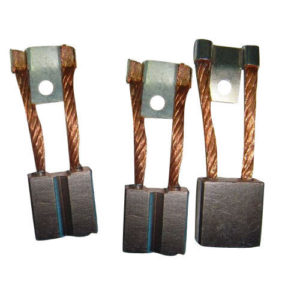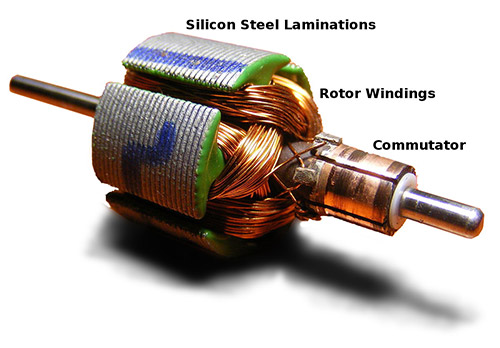DC motors are common and found in a plethora of varying applications, such as vacuum cleaners, food slicers, pizza oven conveyors, vending machines, and many other mechanisms. These motors are simple machines and proper maintenance is important to extend the life of these motors. Below are some of the most common issues you will need to watch for with your DC motor.
• Brush Rack Adjustment: The rack, also called a yoke element, must be correctly adjusted into the “neutral” position. For this to be done correctly, one needs to position the neighboring brushes in an area on the commutator outside, or in between the polarity reference of the armature coils being energized with voltage across the brushes. Keeping brushes in a neutral placement may impede extreme arcing while under load.
 • Carbon Brushes: It is important that DC motors are installed with the proper amount of load. This is extremely important for brush conductivity on the commutator as well as the current density, so that the brushes can maintain the correct lubricity when contacting the commutator under load. If the applied load is not consistent or if the motor has the wrong brush grade, the carbon brushes may wear out faster than normal, thus causing carbon dust to build up within the motor. Carbon dust accumulation within the motor can wear the commutator bars down, which may cause irreversible damage.
• Carbon Brushes: It is important that DC motors are installed with the proper amount of load. This is extremely important for brush conductivity on the commutator as well as the current density, so that the brushes can maintain the correct lubricity when contacting the commutator under load. If the applied load is not consistent or if the motor has the wrong brush grade, the carbon brushes may wear out faster than normal, thus causing carbon dust to build up within the motor. Carbon dust accumulation within the motor can wear the commutator bars down, which may cause irreversible damage.
It is important to keep proper, constant pressure on the brush to the commutator to ensure that the full current density is delivered at the point of contact in order to ease premature wear on the brushes. Carbon dust is destructive and must be removed from within the motor to prevent low megohmmeter (electric meter that measures very high resistance values by sending a high voltage signal into the object being tested) readings. The best way to restrict carbon dust build up is to use compressed air. This will remove any dust still present from within the motor.
• Commutator Maintenance: Just as carbon brushes require maintenance every so often, so does the commutator. It is important that commutator bars are maintained by machining the segmented commutator bars true. These segments are insulated between bars using a molding mica. It is important that maintenance schedules are followed to ensure that the commutator stays round, with no run-out on the surface. If the eccentricity of the commutator is not what it should be, you risk having broken brushes or brush springs, sometimes both. If the commutator ends up out of round, it can be responsible for potential high bars, this could damage the brushes and cause excessive arcing where the brush contacts the copper bars. To prevent the brushes from causing unnecessary damage to the commutator a well balanced armature is recommended.
Keep in mind that keeping the commutator eccentricity to a minimum is important to ensure a longer lasting runtime.
• Drive Maintenance: DC drives can also be a reason that DC motors may not be running as efficiently as they should be. Silicon controlled rectifiers (SCR) may be causing issues within a drive. These problems can be detected at the commutator in the form of excessive arcing at the brushes to the closest ground/metal surface in the end frame; this can be found on the commutator side of the motor. DC drives today are programmed to specifications for horsepower, volts and amperes under load. DC drives may also be equipped with an option for a tachometer (instrument which measures the working speed of an engine, typically in revolutions per minute) to be attached on the end of the motor shaft. Motors may go into overspeed mode if the tachometer or connections are not properly discharged, this happens due to over-voltage at the armature. The drive also reacts to little or no voltage produced by the tachometer; DC drives are designed to shut down the motor in cases like this.
• Mechanical DC Motor Issues: As with any electrical device, maintenance is of the utmost importance. You need properly lubricated bearings to ensure their longevity. Your motor also must be correctly assembled to ease bearing issues, such as misalignment in the end frame housings. To ensure that the motor runs at top performance be sure to check for correct installation and alignment.

• Winding Issues: Another common issue with DC motors is a failed field or interpole winding. Either of these windings may present as arcing at the brushes. It is important when dealing with a failed winding to use the correct data from the manufacturer for the exact specifications. If a DC motor is left unused and the drive has not been set up with a field weakening position, you could have a potential issue with heat from the field windings. Blower systems are often attached to medium and large DC motors to lighten this issue.
A DC motor is a machine all unto itself. It is simple yet complex, but with proper maintenance and care it can last for years to come. Keep in mind that brushes, brush springs, and commutators will always need to have proper maintenance performed to ensure your motor runs effectively.
Our team at Motor Specialty looks forward to helping you keep your DC motors running efficiently for the life of your motor. Call us today for any questions or DC motor needs!
